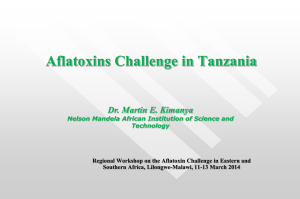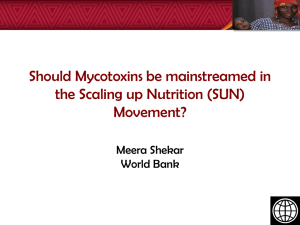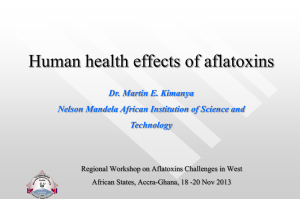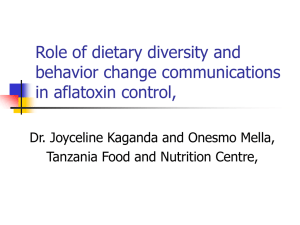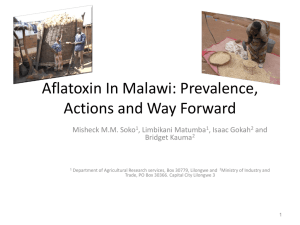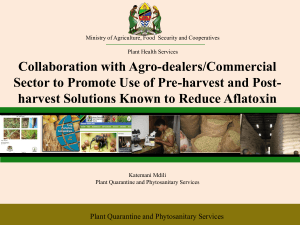Effect of Aflatoxins on T and B Lymphocyte Function
advertisement
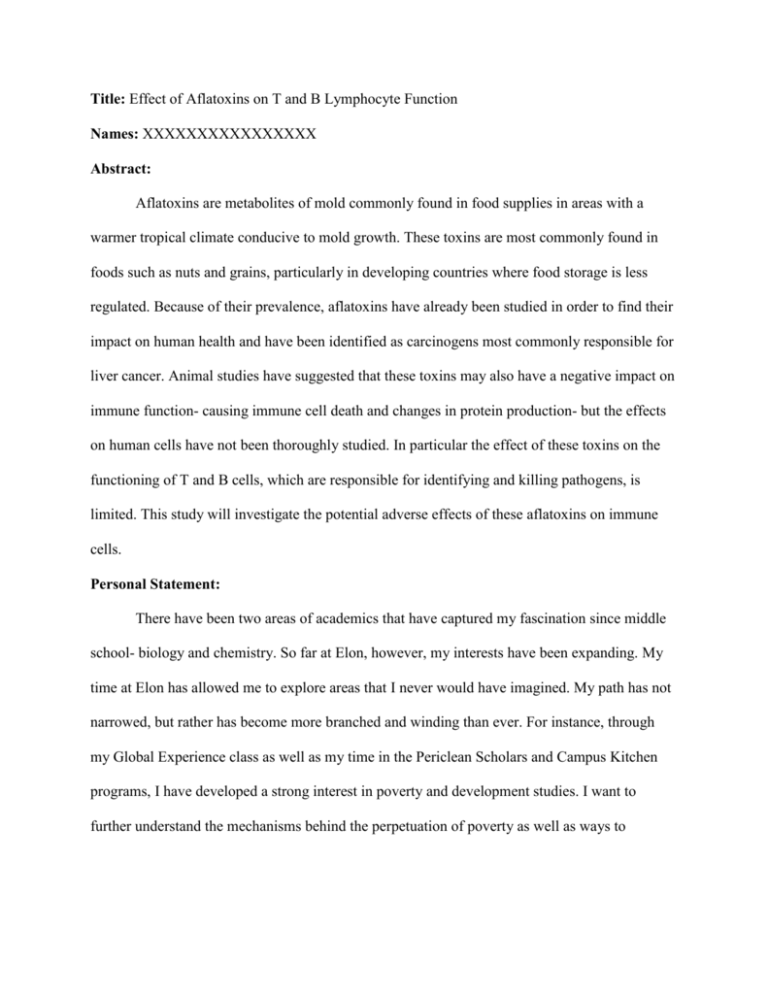
Title: Effect of Aflatoxins on T and B Lymphocyte Function Names: XXXXXXXXXXXXXXXX Abstract: Aflatoxins are metabolites of mold commonly found in food supplies in areas with a warmer tropical climate conducive to mold growth. These toxins are most commonly found in foods such as nuts and grains, particularly in developing countries where food storage is less regulated. Because of their prevalence, aflatoxins have already been studied in order to find their impact on human health and have been identified as carcinogens most commonly responsible for liver cancer. Animal studies have suggested that these toxins may also have a negative impact on immune function- causing immune cell death and changes in protein production- but the effects on human cells have not been thoroughly studied. In particular the effect of these toxins on the functioning of T and B cells, which are responsible for identifying and killing pathogens, is limited. This study will investigate the potential adverse effects of these aflatoxins on immune cells. Personal Statement: There have been two areas of academics that have captured my fascination since middle school- biology and chemistry. So far at Elon, however, my interests have been expanding. My time at Elon has allowed me to explore areas that I never would have imagined. My path has not narrowed, but rather has become more branched and winding than ever. For instance, through my Global Experience class as well as my time in the Periclean Scholars and Campus Kitchen programs, I have developed a strong interest in poverty and development studies. I want to further understand the mechanisms behind the perpetuation of poverty as well as ways to alleviate it. This interest has led me to others in areas such as nutrition, political science, public health, sustainable agriculture, and even Arabic. When developing my research project last spring, I never expected to reach a compromise between my rapidly expanding areas of interest and my distinct biological and chemical interests. I decided to focus on something that particularly excited me about biochemistry research: the immune system, where chemical signals are not only used to communicate between cells, but to identify and destroy foreign pathogens. I am passionate about understanding not only how it works, but what situations cause it not to work. As I looked further into what I wanted to study, I found information about aflatoxins, which have been shown to be capable of entering the body and preventing our immune systems from functioning correctly. But how this occurs has not yet been discovered. Both my interest in immune function and my passion for finding chemical explanations for biological occurrences drew me to this project. As I researched more I found that it connected to my broader interests as well. These aflatoxins are most commonly found in developing countries, where food storage is less regulated and crops such as corn and grains are exposed to mold. The suppressed immune function caused by aflatoxins could be partially responsible for the prevalence of many of the infectious diseases in that area. Because of this, my project has not only allowed me to investigate the chemical interactions of the immune systems, but the larger systems behind the perpetuation of poverty as well. When I look at where I will be in five years, I am not sure exactly which path I will take. I know I am interested in the medical field, either discovering the mechanisms behind diseases that plague impoverished areas or working to stop them, but I haven’t yet discovered what area is the best fit. This project, however, has already helped me see the possibilities for a future career that can combine my multifaceted interests. Receiving the Lumen prize would allow me to explore this project much further, allowing me to gain even more of an understanding of where my passions lie and where they can take me. I will be able to learn more advanced techniques inside of the lab, while also learning how to be a part of a wider community of scholars who share my passions. The prize would allow me to increase the quality and quantity of the experiments that I will perform, through the use of materials and technology of a higher quality and wider variety than those that I would be able to use otherwise. It will allow me to travel to share my findings, helping me to find my place in the scientific community. Overall, the product of my research and my personal growth that will result from it will be greatly supported by the Lumen Prize. Part II: Project Description Focus: Aflatoxins are secondary metabolites of two common mold species, Aspergillus flavus and Aspergillus parasiticus, known for the contamination of animal feeds as well as staple foods such as groundnuts, corn, rice, spices and seeds (1,2). This contamination is common in animal feed as well as food supplies in developing countries, where food-production technology is not developed enough to avoid the conditions conducive to mold growth (2). It is estimated that approximately 4.5 billion people living in developing countries are regularly exposed to this toxin in uncontrolled concentrations (2). In 2010, a study conducted in Texas found that onequarter of the participants had exposures above the daily limit set by the FDA (11). This shows that even in more developed areas where aflatoxin limits are set, significant exposure still occurs. Aflatoxins have been found to be a significant contributor to many acute and chronic health issues, including liver cancer, nutritional interference, and immunosuppression. A study in 2010 estimated that between 4.6% and 28.2% of liver cancer cases worldwide can be attributed to aflatoxin exposure (9). Wide-spread estimates of the effects of aflatoxins on other global health issues have not been as thoroughly investigated. While the role of aflatoxins as a carcinogen in liver cancer has been well-studied, more recently it has been investigated as an immunosuppressant in clinical studies. In a study of Gambian children, those whose blood samples yielded a positive result for aflatoxin exposure showed decreased concentrations of immune proteins in saliva (4). Other studies have found that aflatoxins have a negative impact on cell-mediated immunity. A study on Ghanians found that there was significant aflatoxin exposure in all of their participants. There was a significant decrease in activation of multiple forms of immune cells, including T-cells, B-cells, and macrophages in the participants with “high” aflatoxin levels (greater than 0.9068 pmol/mg) in comparison to those with “low” aflatoxin levels (1). Aflatoxin exposure has also been shown to have a negative effect on the immune function in humans infected with the Human Immunodeficiency Virus and has been shown to speed up the progression of the disease (5,2). Though these clinical studies are useful in identifying the symptoms and diseases correlative with increased aflatoxin exposure, how these aflatoxins interact with our cells and body systems in order to cause these effects cannot be identified. This proposal aims to study the effect of aflatoxin on immune cell function in order to more comprehensively understand the mechanism underlying its immunosuppressive effects. The current research on the effect of aflatoxins on specific immune cells is mainly focused on the functioning of macrophages, which have been shown to be impaired with increasing concentration of aflatoxin (3,6). However, the effects of aflatoxins on other immune cell groups important in the recognition and elimination of pathogens, such as T-lymphocytes and Blymphocytes, have not been thoroughly studied. T-cells are responsible for signaling other major cells of the immune system in order to initiate the immune response and can also directly kill infected cells. These cells are also important for the development of immunological memory, which allows for a more rapid attack of pathogens in recurrent exposure. Mice treated with increasing concentrations of aflatoxin were found to have reduced populations of helper-T cells and B cells as well as reduced antibody responses (10). The proliferation of T-cells is primarily regulated by the production of the IL-2 protein, which was also shown to be present in lower concentrations in the mice treated with aflatoxin. A study performed on plated, human leukemic T-cells focused on the effect of aflatoxins on the production of IL-2. A study found that when stimulated to produce IL-2, the T-cells that were exposed to aflatoxin had lower levels of protein as a result of an impaired production mechanism (7). Therefore, the research on the immune responses of mice suggests that aflatoxins have an adverse effect on T-cell function (2, 7). The aforementioned study performed on blood samples of Ghanaian individuals also suggested that aflatoxins reduced the number of activated T and B cells in the blood samples of their participants, yet the reasons for these decreases are not yet known (1). Other than these studies, the research surrounding the effects of aflatoxins on immune cells is limited. The goal of this research will be to gain further understanding of the effect of aflatoxins on the cells of the human immune system. Based on studies performed on the immunological responses of both animals and humans, it is expected that aflatoxins negatively impact the T and B lymphocyte numbers either by inducing cell death and/or reducing cell growth. As a result, we would also expect the proteins involved in replication to be down-regulated or the proteins responsible for cell death to be up-regulated. To test these hypotheses, human T or B cells will be cultured with or without aflatoxin. The growth of T and B lymphocytes will first be investigated through cell counts as well as assays of signaling proteins involved in the regulation of the cell cycle. Cell death will also be studied through the use of viability tests and flow cytometry. If the results indicate that cell death is occurring, further study of apoptotic proteins, which signal for programmed cell death, will be used to identify the mechanism behind this occurrence. In the case of either impaired growth or increased death signaling, antioxidant compounds can be introduced to cells exposed to aflatoxin in order to see if the harmful effects would be reduced as seen in the studies involving liver cancer (8). Regardless of whether growth or death is occurring, aflatoxins may be modulating immune cell function through dysregulation of enzymes used in signaling, activation, and response to pathogens. If cell growth and death are not significantly affected, the immune response of the cells can be assessed. These responses would be studied by eliciting an immune response after exposing the cells to aflatoxin. Production of cell-signaling and activation proteins involved in identifying and responding to pathogens will then be analyzed through the use of assays and compared to the protein production in cells not exposed to the toxin. These results will be used to better understand the effects of aflatoxins on these cells. Proposed experiences: Research for this project will continue during summer of 2013 through the Summer Undergraduate Research Experiences program. During this time, I will be taught various analytical techniques including cell culturing, as well as various protein assays and blotting techniques. Because of the amount of time that this experience offers, I will have the opportunity to perform many tests on the effects of aflatoxin on cell viability and protein production in order to establish a basis of understanding of those effects. This experience will also offer many opportunities for presentation, including informal departmental presentations as well as formal presentations at the end of the summer and in the fall. I will continue to further develop the project over the next two years at Elon. The techniques learned during the summer of 2013 will allow me to further investigate the aflatoxin effects and further develop my skills in the lab. I plan to take advantage of other opportunities to present my research both at Elon, through programs like the Student Undergraduate Research Forum, and at regional or national conferences such as the American Society of Cell Biology Annual Meeting. To aid in the development of my knowledge and skills, coursework will be selected that provides further insight into my project. I will take Biochemistry as well as Quantitative Chemical Analysis, Human Anatomy, and Microbiology all of which will help me understand processes involved in my research and will build on my laboratory skills. Coursework such as Public Health, Epidemiology, and Nutrition will help me to further understand the bigger picture that my project fits in to. During the winter of 2014 I also hope to participate in the Public Health Study abroad program to northern India in order to work with the Community Rural Health Project. During this experience, I will be able to work with women in the area, as they train to become community health workers, as well as professionals in the field of Public Health. This will allow me to understand the areas that are affected by the toxin that I am studying, while also gaining a better understanding of other health issues in the region. Proposed products: The products of this project will be mainly in the area of scholarly work intended for presentation and publication. The findings that I make over the next two years of my research will be presented, starting with departmental and program presentations for SURE 2013. I hope to also present in the Student Undergraduate Research Forum of 2014. As my project develops further, I plan on presenting at regional or national conferences such as the National Conference of Undergraduate Research or the American Society of Cell Biology Annual meeting. In addition to conference presentations, I will be completing a research thesis for the Honors fellows program and aim to work towards a peer-reviewed publication. Part III: Feasibility Feasibility statement: This project is very feasible, because of the resources and connections that I have as well as my motivation and love for this project. When interviewing to be a part of the Periclean Scholars class of 2015, I told our mentor Dr. Warner that I had a passion for understanding poverty- what systems are behind it existence and what issues it creates. I also told him that I felt that because I had that passion, it was my responsibility to do something about it. By doing this project I am gaining an understanding of an effect and a perpetuating cause of poverty. At the same time, I also have a fascination for the chemical interactions within the body. This project is a combination of both of my passions, which will be a strong motivator throughout the entire project. I am also confident in my ability to complete the experiments necessary to gaining an understanding of aflatoxins’ effects. I have already begun working in the lab with Dr. Train, learning various cell culture and maintenance techniques of which I can build upon as we move forward which more challenging assays. I have been able to learn techniques from both the seniors in my lab and from Dr. Train, which prepare me for the experiments that I will run for this project. I am also confident in the feasibility of this project because of the resources available to me. The Biology Department at Elon is already equipped with equipment and materials that I need, such as the microcentrifuge, the -80oC freezer, blotting kits, cell culturing plates, micropipettors, and some basic antibodies. These have allowed me to start working in the lab on my project and will allow me to do more investigations in the future. Through collaboration with other departments, I will also be able to access more equipment, materials, and knowledge that will aid in the success of this project. By communicating with the Chemistry department, I would be able to use equipment such as the flow cytometer, which would allow me to quickly analyze the growth and activity of the cells that I am studying. In the Environmental Science department, Professor Steve Moore has done research at N.C. State on the effects of aflatoxin on animals; his research may help me gain further insight into my project. Within the lab, Dr. Train has extensive background involving the identification of apoptotic cells and the effects of protective factors on immune cells both of which are major components of this project. Budget: Cells o Jurkat E6.1 Cell Line human o Human Peripheral Blood Mononuclear Cells o Other Cell Lines Total Western Blot Supplies o TGX precast gels o Tris-Glycine-SDS Buffer o Phosphate buffered saline Total Antibodieso Phospho- p44/42 MAPK (Erk ½) o Caspases o Apoptosis Antibody Sampler Kit $369.50 $435.00 $350.00 $1154.50 $208.20 $83.80 $108.00 $400.00 $301.00 $500.00 $489.00 Total Cell Culturing Supplies o Tissue Culture Dishes o 12-well cell culture plates o Fetal Bovine Serum (500 mL) o RPMI media Total Chemical Supplies o Aflatoxin o Other Total Equipment o Micropipetters o Other Equipment Total Conferences o ASCB conference submission o NCUR Conference submission o Posters Total Travel o Flight from Raleigh to Philadelphia Round Trip o Round trip flight to NCUR 2014 o Hotel Expenses o Food Expenses Total $1290.00 $250.90 $296.60 $304.00 $104.00 $955.50 $100.00 $300.00 $400.00 $800.00 $500.00 $1300.00 $100.00 $100.00 $100.00 $300.00 $300.00 $400.00 $300.00 $200.00 $1200.00 Tuition o Fall 2013-Spring 2014 o Fall 2014-Spring 2014 $4000.00 $4000.00 Total TOTAL $8000.00 $15,000.00 Timeline: Summer 2013 Fall 2013 Winter 2014 Spring 2014 Summer 2014 Fall 2014 Winter 2015 Spring 2015 Proposed Experiences Summer Undergraduate Research Experience Preliminary studies to determine the effect of aflatoxin on Jurkat T cell growth and viability HNR498- 2 credits Potentially Attend the American Society for Cell Biology Annual Meeting in New Orleans, LA Expand studies on Jurkat T cells to determine intracellular signaling events. Public Health Practicum: Community Rural Health Project, India HNR 298- 2 credits Continue studies on growth, viability and signaling. Begin preliminary work on primary immune cells. Attend NCUR Conference at University of Kentucky Participate in an REU at a Research Institution HNR 298- 2 credits Attend and Potentially Present at the ASCB Annual Meeting in Philadelphia, PA. Dec. 6-10, 2014 Continue work on primary immune cells. Continue work on project while taking a winter term course HNR 298- 2 credits Perform necessary replications, complete studies in the laboratory and write up results. Proposed Product(s) SURE Presentations Submission of Abstract to the National Conference of Undergraduate Research (NCUR) Student Undergraduate Research Forum presentation Submission of abstract to American Society of Cell Biology (ASCB) Potential Conference Presentation at ASCB Annual Meeting Synthesis of research into an Honors Thesis Submission of publication to PeerReviewed journal List of Sources: 1 Jiang, Y, Jolly, P, Ellis, W, Wang, J, Phillips, T, Williams, J. (2004). Aflatoxin B1 albumin adduct levels and cellular immune status in Ghanians. International Immunology. 17(6):807814. 2 Williams, J, Phillips, T, Jolly, P. Stiles, J. Jolly, C, Aggarwal, D. (2004). Human aflatoxicosis in developing countries: a review of toxicology, exposure, potenital health consequences, and interventions. The American Journal of Clinical Nutrition. 80:1106-22. 3 Bruneau, J, Stack, E, )’Kennedy, R, Loscher, C. (2012) Aflatoxins B1, B2, and G1 modulate cytokine secretion and cell surface marker expression in J774A.1 murine macrophages. Toxicology in Vitro. 26:686-693. 4 Turner P, Moore S, Hall A, Prentice A, Wild C. (2003).Modification of Immune Function through Exposure to Dietary Aflatoxin in Gambian Children. Environmental Health Perspectives. 111(2):217-220. 5 Jiang Y, Jolly P, Preko P, Wang J, Ellis W, Phillips T, Williams J. (2008).Aflatoxin-Related Immune Dysfunction in Health and in Human Immunodeficiency Virus Disease. Clinical and Developmental Immunology 2008: doi: 10.1155/2008/790309. 6 Cusumano V, Rossano F, Merendino RA, Arena A, Costa GB, Mancuso G, Baroni A, Losi E. (1996).Immunobiological activities of mould products: functional impairment of human monocytes exposed to aflatoxin B1. Research in Microbiology. 147:385-391. 7 Han SH, Jeon YJ, Yea SS, Yang KH. (1999).Suppression of the interleukin-2 gene expression by aflatoxin B1 is mediated through the down regulation of the NF-AT and AP-1 transcription factors. Toxicology Letters. 108:1-10. 8 Gross-Steinmeyer K, Eaton D. (2012). Dietary modulation of the biotransformation and genotoxicity of aflatoxin B1. Toxicology. 299: 69-79. 9 Liu Y, Wu F. (2010). Global Burden of Aflatoxin-Induced Hepatocellular Carcinoma: A Risk Assessment. Environmental Health Prospectives. 118: 818-824. 10 Hatori Y, Sharma R, Warren RP. (1991). Resistance of C57B1/6 mice to immunosuppressive effects of aflatoxin B1 and relationship with neuroendocrine systems. Immunopharmacology. 22: 127-136. 11 Johnson NM et. al. (2010). Aflatoxin and PAH exposure biomarkers in a U.S. population with a high incidence of hepatocellular carcinoma. Science of the Total Environment. 408: 60276031.
